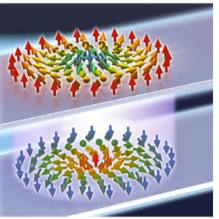Magnetic skyrmions are magnetic nanobubbles which are envisioned as bits of informations in our computers. A team from the Spintec laboratory in Grenoble has demonstrated that they can be moved by electric current at record speeds, up to 900 m/s, in antiferromagnetic stacks. These results hold promise for the use of skyrmions to store and process information more efficiently and with lower energy in computers.
Left Skyrmions in synthetic antiferromagnets are composed of two skyrmions whose spins are aligned in opposite directions. Right Skyrmion velocity as a function of injected current density for skyrmions in SAF (black squares) and in single ferromagnetic layers (blue circles).
Skyrmions are magnetic textures with fascinating properties. This magnetic quasi-particle can reach sizes down to a few nanometers, and is composed of elementary nanomagnets (spins) that wrap to form a very stable spiral structure, like a tightly-knit knot. Skyrmions can also be manipulated by small electrical currents, paving the way for their use as information carriers in computing devices. Several memory and logic devices have been proposed, promising very high information density and low energy consumption.
These devices are based on the manipulation of skyrmions in magnetic tracks by an electric current. However, such applications remained distant, as the magnetic moment of skyrmions limits their speed to 100 m/s – too slow for applications – and leads to a deflection of the skyrmions’ motion towards the edge of the track, where they can annihilate. Researchers at the Spintec laboratory have shown that these limitations can be overcome in synthetic antiferromagnetic materials. These materials consist of two nanometer-thick ferromagnetic layers (such as cobalt), separated by a thin non-magnetic layer, with opposite magnetizations. The skyrmions in synthetic antiferromagnets are composed of two skyrmions whose spins are aligned in an opposite direction, thus cancelling out the magnetic moment (Figure 1, left). The Spintec team has shown that skyrmions in these materials can be moved by electric currents almost ten times faster than ferromagnetic materials, up to 900 m/s, and along the direction of the current (see Figure 1, right). The experimental results are in good agreement with the predictions of theoretical and numerical models. The next step will be to perform memory and logic operations based on skyrmion train manipulation in these materials, a step closer to using these new particles to encode and manipulate information at the nanoscale. These results were recently published in the journal Science.
Teams: Spin Orbitronics, Theory and Simulations, Materials growth
Collaboration: Institut Néel (France)
Funding: TEE DARPA, PEPR SPIN
Further reading:Pham, V. T. et al. Fast current-induced skyrmion motion in synthetic antiferromagnets. Science 384, 307–312 (2024). Open access: hal-04553207
Contact: Olivier Boulle

